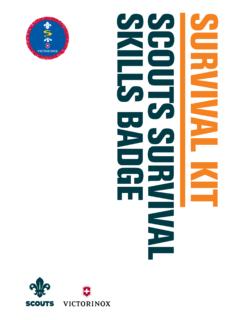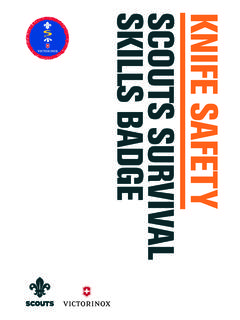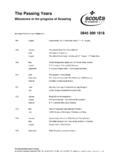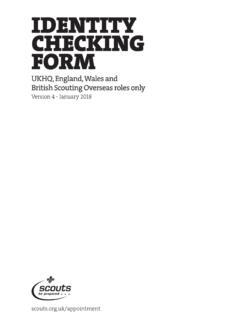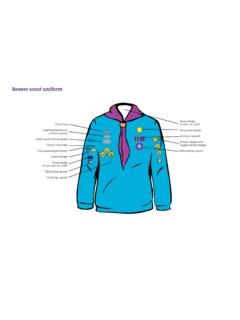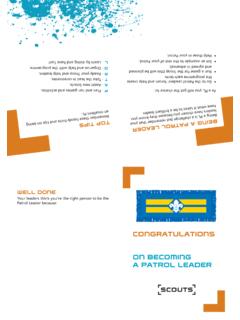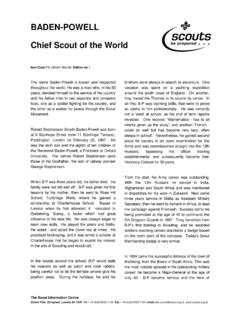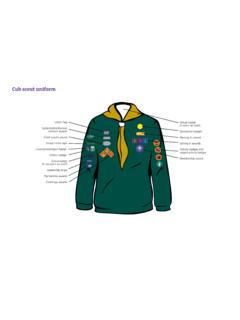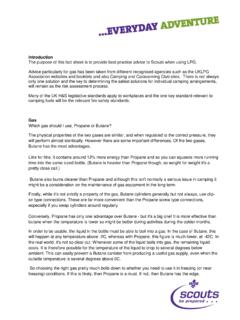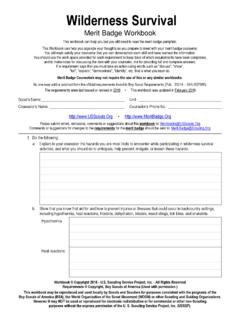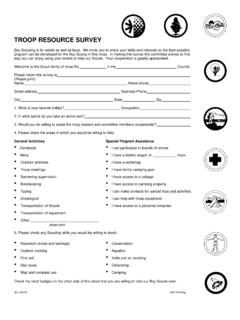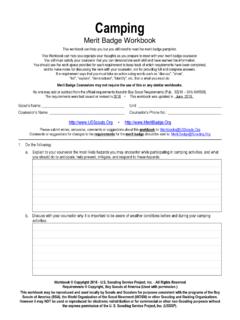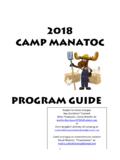Transcription of SKILLS BADGE - Scouts
1 BUILDING A FIRESCOUTS survival SKILLS BADGECONTENTSPage 3 Introduction SafetyPage 4 Where to build your firePage 5 Tinder, Kindling and Fuel Page 6 Firelighting Page 7-8 Firelighting tips & tricks Page 9 How to light a firePage 10-12 Types of firePage 13 Burning properties of woodsPage 14 Activity sheetTHANKS TOAustin LillTerry Longhurst22nd Hampstead Sea Scout Group15th Chingford Scout Groupfor their contributions to this resource. April 2015 The Scout Association. Registered charity numbers: 306101 (England and Wales) and SCO38437 (Scotland)2 The Scout Association recognises that bladed and sharply pointed hand-tools are important for working on survival SKILLS . We promote the safe use of knives used as a tool reiterating UK Law. Knives with a fixed non-folding blade, a folding knife with a blade over 3 inches in length or a folding knife which locks in place require the person carrying such a knife in public (whatever age) to have good reason for carrying the tool.
2 It is illegal to sell such a tool to a person under 18. The Scout Association holds no responsibility from injuries that have occurred as a result of using this resource. Whenever a knife is to be used, or any other activity a risk assessment must be made and suitable controls put in AND VICTORINOX DISCLAIMER3 Scout survival SKILLS : Building A Fire@ is a fundamental skill in scouting and is vital for survival . A fire provides warmth, a place to cook or boil water as well as a focal point for the camp. Knowing how to light a fire as well as extinguish and clear away afterwards will ensure Scouts are prepared for a survival situation and leave no harmful impact on the area they camp in. SAFETYIf it is not watched or properly controlled, your campfire can be dangerous both to people and the natural surroundings. Fire can spread quickly especially in dry conditions and a stray ember can be enough to start a forest fire.
3 Follow the safety measures on where to build your fire to ensure your campfire is a safe and happy or accidental fires can cause damage to wildlife and habitats as well as people and property. Take care with matches not only during dry summers but at all times of the year. Sometimes vegetation is burned on purpose as a way of managing the woodland usually between October and early April, so check that a fire isn t being supervised before calling safety factors to consider never leave a fire unattended check if there is anything you need to know about the area you are camping in, for example, is it prone to bush fires in dry summers and are there protected species of trees or plants nearby don t build a fire bigger than you need check the direction and strength of the wind which can make a fire flare up and blow sparks out of the fireplace that could set light to other areas do not build your fire too close to your shelter as sparks or exploding embers could burn it never use methylated spirits, paraffin, petrol or any other chemicals to start or rekindle a fire.
4 As chemicals are volatile and even vapour from these can catch light don t use riverbed rocks or flint to edge your fireplace as they can sometimes explode when they get hot hot ashes or coals: do not bury hot ashes or coals as you may set light to roots and cause a fire to spread both under and over ground keep loose clothing tucked in and long hair tied back around a fireMake sure you familiarise yourself with the First Aid treatment for burns before you build a fire. Ensure a First Aid Kit and water is nearby for treating small or minor burns. More serious burns will require professional medical treatment at a AID4 Scout survival SKILLS : Building A Fire@ TO BUILD YOUR FIRECAMPFIRESPREPARING THE GROUND FOR A FIRE AND EXTINGUISHING A FIREUse a spade to cut through the turf and outline a square where you will build your fire. Divide it into smaller squares and slide your spade under the squares and lift them off.
5 Store the squares away from the fire grassy side down and water them frequently to avoid them drying out as you will be replacing them when you leave the or bank the cleared area using large stones, logs, bricks or mounds of soil. This keeps the fire and its ashes in place and protects it from the wind. The edging material should be spaced out a little to allow air to flow into the base of the a campfireStop adding fuel and wait for the fire to burn down and turn to ash. Break down large logs by knocking them with a long stick so they will burn quicker. Once it has turned to ash, pour water on all parts of the fire and stir the ashes with the stick to make sure that all the embers are put out. Check no stray embers have escaped. Pour water over it again and carefully check that the ashes are cold to the away a fireplaceScouts should leave no trace of their time at a campsite.
6 If you leave the campsite completely you must clear away the fireplace. If you are camping in the wilderness pile any remaining embers up to burn them off then dig over the fireplace so there are no ashes left on the surface. Check that the fire is fully out and any remaining small pieces of wood can be scattered into the surrounding foliage. Scatter fresh soil over the area then smooth it down and water it well. If a fire has been alight for a long time then make holes in the ground to allow water in to cool the ground below the surface. If you cut out turf when you arrived, replace it now and fill in any gaps with soil, grass and leaves to look as natural as campfires are the focal point of a camp and a lot of time will be spent using it for cooking food, boiling water and sitting round it keeping warm, singing or talking always get permission from the landowner or campsite owner before starting a fire fires can cause damage so think carefully about where you locate it and the effect it will have on the ground and the surrounding area it is unlikely that an open fire will be allowed at a commercial campsite but if it is it will probably have an allocated area build your fire on a level area with plenty of space around it light a fire well away from trees, hedgerows and anything flammable.
7 Close to a source of fuel but not too close try to build on a spot where a fire has been built before do not light a fire on grass, especially in dry conditions as it could spread outside of the fireplace and get out of control very quickly5 Scout survival SKILLS : Building A Fire@ IS KINDLING? It keeps the fire going once you have a spark and a does it look like? Consists of small sticks and splinters from the size of a match up to a pencil. It s bigger than tinder but not as big as logs or large pieces of wood. What else do I need to know? Kindling needs to be bone dry to catch light more easily. Be careful not to put too much kindling on your fire, or too large pieces too soon as you may smother the fire. WHAT IS FUEL? Builds up your fire and keeps it does it look like? For most campfires, medium-sized sticks and logs (up to the maximum thickness of your arm) are fine for fuel.
8 What else do I need to know? Wood should ideally be dry, seasoned wood (although ash can be burnt green), this is because fresh wood has more moisture which affects the burning quality and generates smoke. Logs and sticks should be laid on the kindling carefully, or built as part of the construction of your fire. Be careful not to put the fire out as you add , kindling and fuel are three essential ingredients for firelighting. You should collect plenty of materials before starting to light your fire as you do not want to leave it unattended to gather more fuel. Lay out the materials in order of thickness so you can feed the fire slowly and gradually, which should give the best IS TINDER?Small, dry, highly flammable material used primarily to catch a does it look like?Examples include wood shavings, crumbled rotten wood (also called punk), dried grass, birch bark, leaves, string and even fungus such as crampballs (also called King Alfred s cakes as they resemble burnt buns).
9 What else do I need to know? Different type of tinder are used depending on how you are lighting the fire. If you have a lighter then birch bark is a good choice. TINDER, KINDLING AND FUEL6 Scout survival SKILLS : Building A Fire@ takes practise and good-quality equipment and materials to get the quickest and best results. Preparing your firelighting kit in advance will pay off on a cold, wet night when you need your fire the RODA ferro rod and striker is a reliable firelighter and will stand you in good stead for many camping trips. It can be used to light a range of tinder and will guarantee a spark in the wettest of AND STEELA flint and steel set can be struck together to create a spark. It is not as hot or reliable as a ferro rod and can only ignite high quality natural tinder or prepared tinder such as are many different kinds of lighter available.
10 A cheap disposable lighter will be fine in fair weather conditions, but will prove less reliable in strong wind and rain. In bad weather or for effective results a storm-proof lighter is recommended. These use butane and have a better delivery MATCHESW aterproof matches were originally developed for the Ministry of Defence. The flame cannot be blown out and the matches light up even when they are wet. They re available from good outdoor equipment your firelighters in a metal survival SKILLS : Building A Fire@ TIPS AND TRICKSF eather StickFeathersticks are better than wood shavings as you can move them about in a bundle to catch a flame. They allow oxygen in and, unlike shavings, can prevent moisture getting into the wood from the ground. Find a dry stick approximately 2-3cm in diameter. Use your Swiss Army Knife to slice thin strips down the sides, making sure they stay attached at the bottom.
